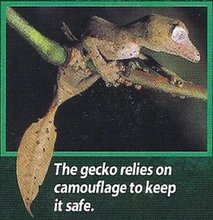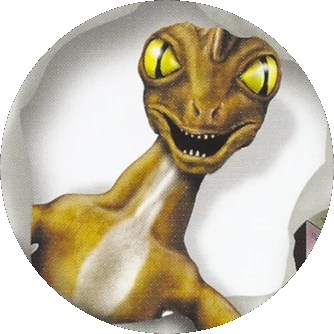If you could ever actually spot a leaf-tailed gecko in the wild, you would see one strange looking lizard. This creature wears a suit of perfect camouflage that blends in with tree bark and fungi; its skin is patterned and colored with earth tones to make the lizard almost invisible. While the leaf-tailed gecko is hard to spot, its huge eyes help it see both predators and prey, even on the darkest of nights.
Sticky Situation: Millions of tiny bristles and pads cover each of this gecko's fat toes. This helps the creature scurry over nearly any surface, including glass, to chase down insects or escape from enemies. The gecko can even walk upside down on ceilings.
Night Goggles: The leaf-tailed gecko hunts insects in trees and bushes only after the sun goes down. The creature's eyes are huge so they can gather as much moonlight as possible to see in the dark of night.
On the Fringe[]

The gecko relies on camouflage to keep it safe.
The leaf-tailed gecko is a tasty treat for predators such as snakes and birds, so it needs a few tricks to stay alive in the wild. This reptile's skin is wildly patterned like moss or bark, and has frilly edges to blend in with its surroundings. This disguises the creature's outline and hides its shadow from enemies. Even the creature's tail, which gives this gecko its name, is wide and jagged to look like a leaf. If spotted and attacked, the leaf-tailed gecko can break off its tail, which bleeds and wiggles on the ground; this allows the gecko to escape while the enemy attacks the "dancing" appendage.
Night Stalker: The gecko needs heat to stay active, but can't bask in the sun because it hunts at night. As the sun sets, it crawls into a warm crevice to absorb energy.
Self Cleaning: When it comes to keeping clean, few creatures can match the leaf-tailed gecko. This creature cleans its entire body with its long tongue after every meal-and can even lick its own eyeballs!
Cannonball![]
- As a leaf-tailed gecko searches for insects to gobble up with its long, sticky tongue, a predator sneaks up behind it. The gecko sees the enemy just in time and jumps from its branch.
- The gecko curls up into a ball in mid-air, which speeds up its descent and protects its limbs when it hits the ground. The small reptile bounces harmlessly when it lands.
- When safely on the ground, the gecko straightens its body and runs directly into the dense undergrowth so it can avoid any other nearby creatures.
Trivia[]
- The species used in the illustration on the front, as well as in the photo on the back right, is most likely a giant leaf-tailed gecko (also known as a common flat-tail gecko) (Uroplatus fimbriatus).
